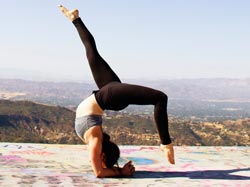-
Yoga

Quality of life is desired and expected, however, a serious question need to be answered- "How much have we achieved and at what cost".
We effortlessly tend to accept the promise of biological medicine as it gives an explanation to the cause of our misery blaming the pathological process rather than changing our life style.

Man has unconsciously tried to be forever young and immortal. The basic question "How life can be made better" is constantly been researched and addressed since antiquity. Various methods have been explored to achieve this goal, which has been rewarding to a larger extent. Recent medical science has achieved considerable short term results, and addressed the symptoms, having also prevention capability. However, medical science has not been able to answer many questions, for example schizophrenia, may be diagnosed and treated, although the specific cause has not been established.
We effortlessly tend to accept the promise of biological medicine as it gives an explanation to the cause of misery blaming the pathological process rather than changing our life style. Prescribing and consuming medicine is an economical and convenient method to deal with illness as it facilitates quick relief, although it comes with side effects.
The important issue is how lives can be made better in a culture that is focused on technology, money making and comfort seeking. Yoga and meditation introduces a person to self actualization and higher thinking, so that he could live more authentically and freely, rather than shrink into the materialistic world. Yoga facilitates and helps one to achieve good physical health, mental and emotional balance and above all true happiness.
Yoga needs to be adopted as a lifestyle and not restricted to time, place, person or situation. It helps in stress reduction and in treatment of various chronic disorders such as asthma, anxiety, depression and many other psychosomatic disorders. Practice of yoga in medicine which is practically devoid of side effects is a good option, and need to be incorporated into our lives.
Yoga History
The Indian sage Patanjali wrote the original description of the yoga system in the Yoga Sutra around 5000 years ago. This text is a unique blend of theoretical knowledge and practical application and remains to this day the primary text of yoga.
The roots of yoga are highly spiritual. The term yoga is made up of two components, "Yog" and "a", meaning union of aatma; it implies connecting with the divine power. The yoga system is a comprehensive description of an approach to life both practically and spiritually. It puts forward eight limbs of yoga:
- Yama - Also known as abstentions or extinction of wrong habit, it helps one to develop forgiveness, fearlessness, non-violence, firmness, compassion, straightforwardness, truthfulness, faith in self and the teacher.
- Niyama - Refers to auxiliary virtue or moral purification and promotes avoidance of moral infarction and leads to gradual construction of new positive behaviors. It helps to develop austerity, contentment, charity, knowledge of philosophy, recitation of mantras and modesty. It results in internal and external purity.
- Asana - These refer to dynamic position of the human body or meditation postures statically maintained for a certain length of time. Mastering this stage is important for dharana, dhyana and samadhi. There are sixteen forms of asanas. Besides the role of asanas in mental and spiritual realm, it helps in physical health and maintains body vigor.
- Pranayama - Control of vital breath, by breathing exercises. It is important for physical health and maintaining peace of mind.
- Pratyahara - Control of mental activities. Here one withdraws his attention from his perceptual cognition. He may see but does not look; he may hear but he does not listen.
- Dharana - Concentration of mind or capability of focusing on fewer objects until he is aware of only one.
- Dhyana - Concentrated meditation or effort to direct the full impact of consciousness upon the self, beyond any memory of ego.
- Samadhi - This is the final stage of development of 'Transcendental super consciousness' or perfect absorption of thought in one object thus getting total release from bonds of the world (Singh,2006)
Yoga in modern times...
The perception of yoga is welcome to heal the physical and mental illness. However this is a fragmented approach and not a complete one. Yoga is internal, subtle, complete and authentic in its form which is also the ultimate path leading to self realization, the path followed by the ancient yogis of India with regular discipline(sadhna).
This unique invention of sage Patanjali when used in its entirety by practicing all the 8 limbs together will result in achieving its full potential. However by neglecting the spiritual side of yoga one will not be able to achieve all that it was first invented for.
The lack of spiritual awareness is the cause of chaos whether it is politics, society, administration, religion, law and education. Terrorism, atheisms, communism, racial discrimination, social inequalities and criminality can only be tackled by spiritual practice of yoga and not by posture (asanas) dominant yoga.
An important element of yoga is known as "Asana". However this is only one limb of the yoga process given by sage patanjali. Yoga not only means Asanas and Pranayam it also includes the practice of Yam, niyam, pratayahara, dharna, dhyan , Samadhi. Today, self proclaimed and modified approaches to asanas or postures of yoga exercise has been extensively popular whilst ignoring the scientific research and other valuable aspects of the yoga system.
The practical application of yoga makes it a popular discipline of healthcare. Yoga is a secret science and its experiment can lead one to tap into the vast energy pool of the 4th dimension that is spiritual in nature and is hidden in each of us.
Meditation known as "Dhyana" is equated to concentration by the new age gurus. It is understood that we concentrate when we read, drive, but meditations is a state when we achieve a state of unisome with the world, a mental process of seeing through the senses. To achieve the benefits of yoga and meditation, we need to follow the eight fold path as prescribed and evidence based scientific research that the yogaphysician tries to deliver through its programs.
Types of Yoga
Multiple yoga sects exist, the important ones are as follows:
- KRIYA YOGA: is a preparatory yoga and enables a person to measure his capability in the light of his desire to attain SAMADHI (perfect absorption of thought in one object, particularly in the light of one's apprehensive troubles (KLESAS).
- KARMA YOGA: provides the means to attain enlightenment through banal social activities.
- HATHA YOGA: is one of the most popular sects where attainment of higher self is achieved by physical, physiological and psychological training. Here, complicated bodily arrangements are practiced for therapeutic purposes amongst many others.
- BHAKTI YOGA: is a yoga system that professes to complete veneration of personified deities. Deep emotional involvement is the most important criteria for the success in this sect.
- JNANA YOGA: this path of spiritual realization through a speculative philosophical search for truth. This forms the basis of achieving enlightenment.
- MANTRA YOGA: in which special and sacred words are CHANTED as principal exercise. MANTRA is a deep devotional incantation.
- RAJA YOGA: most popular sect used as a therapy tool. It emphasis on attaining mental development, mental self-control by mental practice.
- TANTRIC YOGA: utilizes the mystic, but physiological notions of increasing the psychic power based on power called KUNDALINI, which are awakened and brought to SAHASTRA centre (Singh, 2006).



